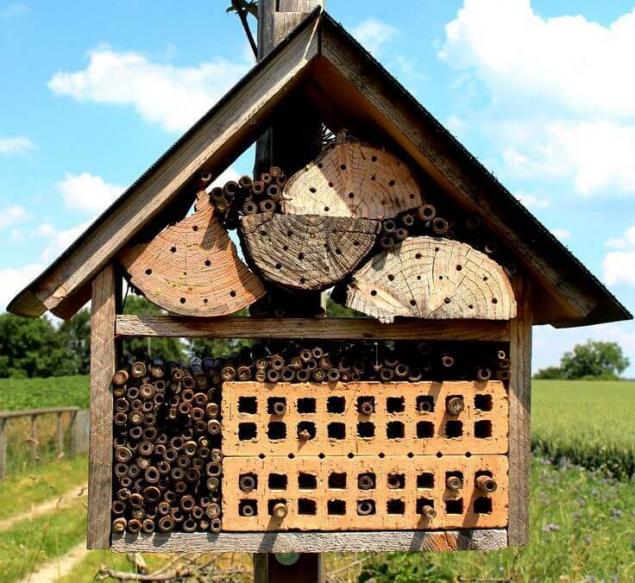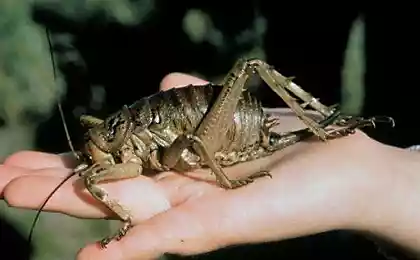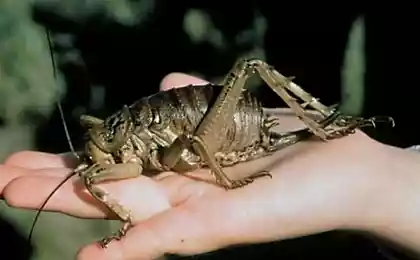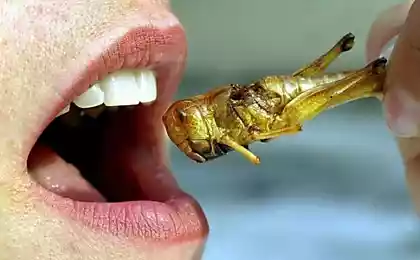787
How to attract to your garden beneficial insects
Combat harmful insects devoted whole treatises. Less write about beneficial insects. And very very few understand how to attract them to the garden.
In Europe, the owners of garden plots placed special houses of refuge for insects, like nest boxes for birds.
They are made very simply, and some "models" will not only help to protect the garden from pests, but also decorate it. Bricks, old boards, straw, bamboo tubes – nothing special, you do not need. Knowledge of the habits of useful insects and fantasy can transform the old junk in the conceptual design objects.

Anyone trying to get into the garden?
The first thing to say about ladybugs. This bright little beetle is known to all. Not all, however, know what is harmless for humans creation – voracious carnivores, eagerly consuming smaller animals, mostly aphids. Especially great is the appetite of larvae.
The larva of ladybugs – not too pleasant a creature without wings, with bright spots on a dark back. But seeing such a "worm" on the sheet, don't be tempted to destroy it. In many countries, ladybirds are bred specifically for sale to gardeners. A few dozen bugs are capable of producing serious devastation in the ranks of the aphids.
Another enemy of aphids – zlatovlaska. Adult resembles a moth with delicate transparent wings, folded house, and shiny Golden-green eyes, her larva is not inferior in its predatory habits of the larvae of ladybugs.
Huge for its size, of course, curved jaws she grabs aphids and drains them, leaving only an empty skin. In their habits zlatovlaska previously wore the proud title of "clevy lion." The grown larva, like a fur coat, covered in a layer of empty skins, which she carries around on itself for protection from the sun and for the best disguise.
Many kinds of flies feed on nectar and lives on the flowers, pollinating them as bees. Often they look very similar to bees, wasps and bumblebees. The larvae of some hover flies – also predators crawling all over plants in search of prey.
First and foremost, remember that any mass insecticide treatments leads to the death of not only pests that will quickly regain its strength, but also their helpful and handsome neighbors, reproducing much more slowly. Sold in Europe houses for ladybirds and butterflies" usually look like little similarity birdhouses or mailboxes.

Sometimes they are interestingly decorated and adorn the suburban area. You can make this house your own. However, we must recognize that the building is purely decorative, as neither the ladybirds or butterflies in the summer season the houses are not required. If not specifically to attract them with pheromones, or formula, to get there they will except by accident.
As for wintering, hibernating insects do need a shelter where they could survive the cold. In our climate such shelters, it is desirable to arrange the closer to the ground below them was covered with snow.
The old woodpile, laid on the ground boards, pieces of bark, piles of leaves and wood shavings were collected under the shelter motley crew. Here and millipedes – drupe and millipedes, worms, and, of course, insects – ground beetles, various larvae, earwigs. Earwigs usually considered pests, but to damage the plant they start only if will greatly multiply. At the same time, the earwig is not averse to hunt for insects.
Some cardboard tubes with a diameter of a little finger or with a pencil and a length of 15-20 cm, tightly closed at one end, will serve as an apartment house for solitary bees.

Unlike social bees and wasps, they are quite aggressive even in close proximity to their homes, thus pollinate plants better than home honey bees. Some species of bees also become rare in the European part of our country.
A bundle of tubes (horizontal) can be hung under the roof of the house, barn, or any other protected from the rain. Or to make a house for ladybirds and fill it densely Packed tubes. Instead of paper tubes you can take sections of the stems of the umbrella, cane or similar plants. In them the bees live solitary in nature.
You can neverlet holes in a piece of wood. A similar structure called "Fabre beehive" – the famous French naturalist Jean-Henri Fabre was the first to decide such a simple way to settle solitary bees just under the roof of his house. To watch their work and habits very interesting.

15 useful tips for garden
What to do with plant debris and waste in the country
Insects need not only shelter but also food. With the exception of raptors, most of the creatures here feed on nectar of flowers. Different types of plants attract them equally. Bees, wasps, flower flies are most fond of dill and other Umbelliferae during flowering, yarrow, mustard, coriander, mint. If the site has kurcinka-other such plants, the presence of various insects is guaranteed.published
P. S. And remember, just changing your mind — together we change the world! ©
Source: vk.com/dacha.life?w=wall-83256656_24426
In Europe, the owners of garden plots placed special houses of refuge for insects, like nest boxes for birds.
They are made very simply, and some "models" will not only help to protect the garden from pests, but also decorate it. Bricks, old boards, straw, bamboo tubes – nothing special, you do not need. Knowledge of the habits of useful insects and fantasy can transform the old junk in the conceptual design objects.

Anyone trying to get into the garden?
The first thing to say about ladybugs. This bright little beetle is known to all. Not all, however, know what is harmless for humans creation – voracious carnivores, eagerly consuming smaller animals, mostly aphids. Especially great is the appetite of larvae.
The larva of ladybugs – not too pleasant a creature without wings, with bright spots on a dark back. But seeing such a "worm" on the sheet, don't be tempted to destroy it. In many countries, ladybirds are bred specifically for sale to gardeners. A few dozen bugs are capable of producing serious devastation in the ranks of the aphids.
Another enemy of aphids – zlatovlaska. Adult resembles a moth with delicate transparent wings, folded house, and shiny Golden-green eyes, her larva is not inferior in its predatory habits of the larvae of ladybugs.
Huge for its size, of course, curved jaws she grabs aphids and drains them, leaving only an empty skin. In their habits zlatovlaska previously wore the proud title of "clevy lion." The grown larva, like a fur coat, covered in a layer of empty skins, which she carries around on itself for protection from the sun and for the best disguise.
Many kinds of flies feed on nectar and lives on the flowers, pollinating them as bees. Often they look very similar to bees, wasps and bumblebees. The larvae of some hover flies – also predators crawling all over plants in search of prey.
First and foremost, remember that any mass insecticide treatments leads to the death of not only pests that will quickly regain its strength, but also their helpful and handsome neighbors, reproducing much more slowly. Sold in Europe houses for ladybirds and butterflies" usually look like little similarity birdhouses or mailboxes.

Sometimes they are interestingly decorated and adorn the suburban area. You can make this house your own. However, we must recognize that the building is purely decorative, as neither the ladybirds or butterflies in the summer season the houses are not required. If not specifically to attract them with pheromones, or formula, to get there they will except by accident.
As for wintering, hibernating insects do need a shelter where they could survive the cold. In our climate such shelters, it is desirable to arrange the closer to the ground below them was covered with snow.
The old woodpile, laid on the ground boards, pieces of bark, piles of leaves and wood shavings were collected under the shelter motley crew. Here and millipedes – drupe and millipedes, worms, and, of course, insects – ground beetles, various larvae, earwigs. Earwigs usually considered pests, but to damage the plant they start only if will greatly multiply. At the same time, the earwig is not averse to hunt for insects.
Some cardboard tubes with a diameter of a little finger or with a pencil and a length of 15-20 cm, tightly closed at one end, will serve as an apartment house for solitary bees.

Unlike social bees and wasps, they are quite aggressive even in close proximity to their homes, thus pollinate plants better than home honey bees. Some species of bees also become rare in the European part of our country.
A bundle of tubes (horizontal) can be hung under the roof of the house, barn, or any other protected from the rain. Or to make a house for ladybirds and fill it densely Packed tubes. Instead of paper tubes you can take sections of the stems of the umbrella, cane or similar plants. In them the bees live solitary in nature.
You can neverlet holes in a piece of wood. A similar structure called "Fabre beehive" – the famous French naturalist Jean-Henri Fabre was the first to decide such a simple way to settle solitary bees just under the roof of his house. To watch their work and habits very interesting.

15 useful tips for garden
What to do with plant debris and waste in the country
Insects need not only shelter but also food. With the exception of raptors, most of the creatures here feed on nectar of flowers. Different types of plants attract them equally. Bees, wasps, flower flies are most fond of dill and other Umbelliferae during flowering, yarrow, mustard, coriander, mint. If the site has kurcinka-other such plants, the presence of various insects is guaranteed.published
P. S. And remember, just changing your mind — together we change the world! ©
Source: vk.com/dacha.life?w=wall-83256656_24426





















